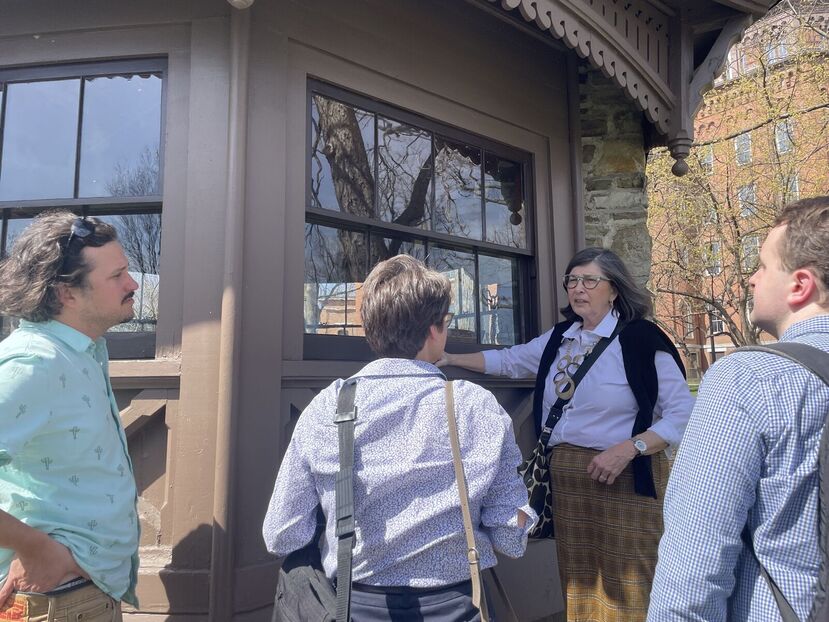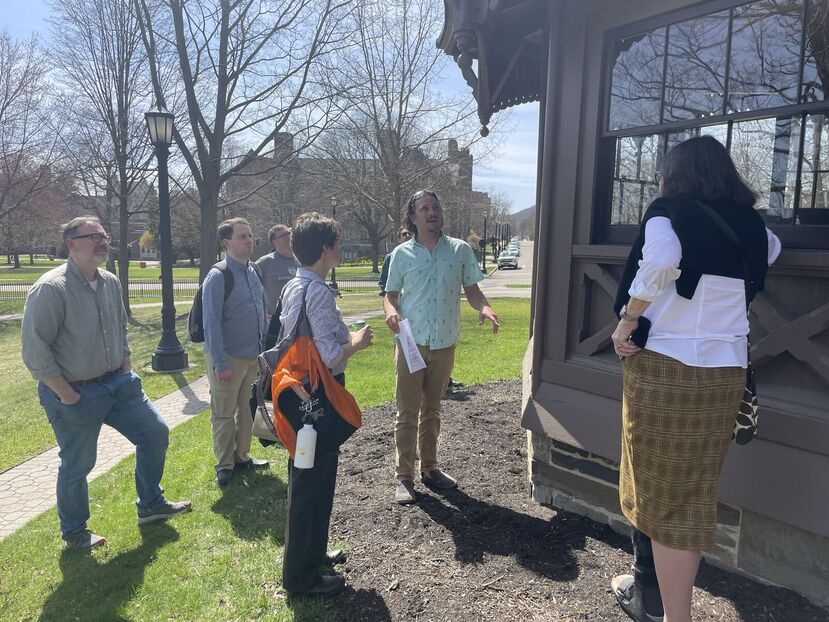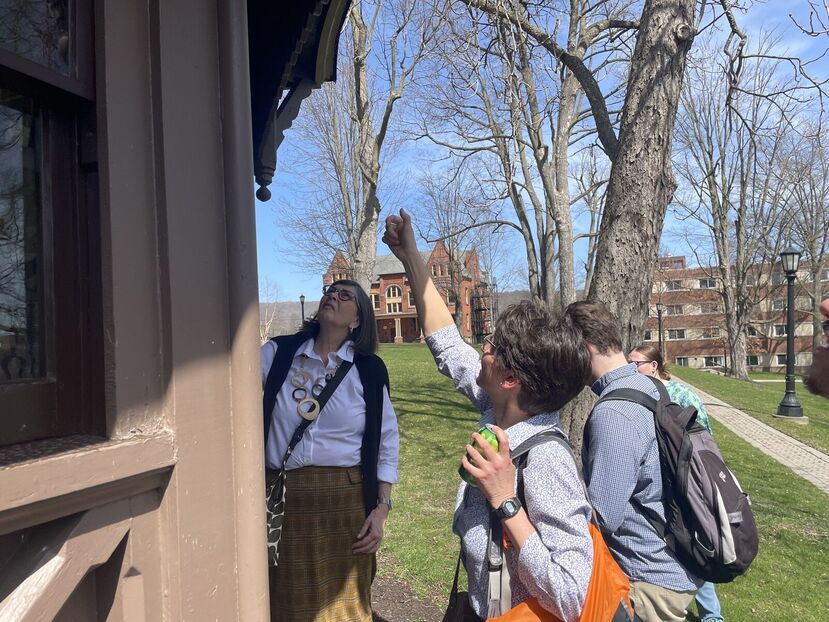News
Check out our news section to learn about all that's going on at Elmira College.
Commencement May 19
Click for weekend schedule, how you can attend!

Left to right: Dr. Trevor Browning, Alicia Campbell, Elise Johnson-Schmidt, and Alex Whydell (Historic Preservationist, Johnson-Schmidt & Associates) chat about where to take additional paint samples from the study.
There’s a historical mystery on the Elmira College campus that a team of EC professors and students will soon undertake solving. Their task is to find the right composition of sand and paint needed to restore the Mark Twain Study to its original color.
A smooth brown paint currently adorns the Study where Mark Twain wrote parts of his most famous works, including The Adventures of Tom Sawyer, The Adventures of Huckleberry Finn, and A Connecticut Yankee in King Arthur's Court. However, recent research conducted as part of an ongoing renovation project to honor the Study’s sesquicentennial (150-year anniversary) this year uncovered that the octagonal building, which sits on the EC campus, was originally painted gray and then sandblasted (sand forcefully added to a painted exterior to give the building texture).

Left to right: Dr. Joseph Lemak, Alex Whydell, Dr. Daniel Kjar, Alicia Campbell, Dr. Trevor Browing, and Elise Johnson-Schmidt.
Dr. Joseph Lemak, Director of the Center For Mark Twain Studies (CMTS), is working with Elise Johnson-Schmidt and her team at Johnson-Schmidt & Associates, Preservation Architects as well as Alicia Campbell, owner and principal of Campbell Restoration and Consulting LLC, to work out how best to restore the interior and exterior surfaces of the building. Yet this particular project requires some additional science know-how.
Given the wealth of expertise at Elmira College, the team invited several EC professors and Jessa Barton ’24, a History major interested in restoration. Together, they will use their scientific and material science knowledge to track down missing details necessary to move ahead with the renovation.
“I think it’s wonderful that CMTS has the opportunity to work with EC faculty in the natural sciences, fine arts, and social sciences. This project demonstrates the power of a liberal arts education here at Elmira College,” said Lemak. “CMTS is committed to taking an interdisciplinary approach to studying Mark Twain, whether it’s his texts, his life, or his world. We encourage scholars, writers, and artists to let us know about the projects they are working on, including people working in the field of historic preservation.”
The assembled team of EC specialists includes:
Dr. Daniel Kjar, Associate Professor of Biology
Dr. Trevor Browning, Assistant Professor of Environmental Science
Chris Longwell, Associate Professor of Art
Dr. Veronica Moorman, Associate Professor of Biochemistry
Dr. Mark Pitner, Associate Professor of Asian History
Jessa Barton '24, History Major
During a meeting to get the project started, the team looked at a magnified image of a paint cross-section taken from the Study. It shows multiple layers of paint, many of which are some variation of the color brown. However, The first layer of paint is gray and contains cavities, some of which still have particles of sand in them.
As the team viewed the image, they discussed how the cavities are found deep in the thick coat of paint. The gray paint was at least twice as thick as subsequent layers, leading the team to question if there were two coats or one very thick coat.
Another question the team will explore is which method of sandblasting was likely used by the original crew. When the Study was built in 1874, the practice of sandblasting was typically used by the wealthier class. For example, the main house on Thomas Jefferson’s Monticello plantation and George Washington’s Mount Vernon home were sandblasted.
There are three possible methods for applying the sand to the paint: add sand to the paint before it is applied to the building, throw the sand onto the paint while it dries, or use an air gun to propel the sand as the paint dries. Initial research indicates that, based on the depth and distribution of the particles in the original coat of gray, the sand was most likely added after the paint was applied. But no one is certain if an air gun was used or not.
The team will also try to work out the composition of the sand. For example, did the sand come from a local deposit, somewhere further away in the region, or was it purchased by one of the glass manufacturing companies, such as Corning Glass Works (now Corning Incorporated)?

Left to right: Elise Johnson Schmidt, Alicia Campbell, Alex Whydell, and Dr. Veronica Moorman
The answers to these questions and more will inform the paint color and sand-blasting process used later to restore the Study to its original color. CMTS is applying for a grant from the Preservation League of New York to help fund the restoration of the interior and exterior surfaces of the Study. In the meantime, the professors intend to enlist additional students to aid in the research, much of which will be done over the summer.